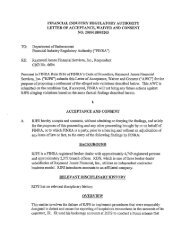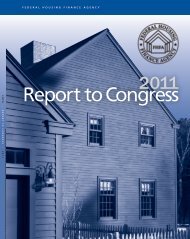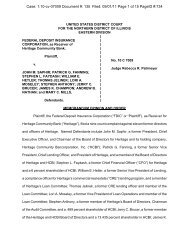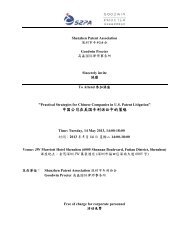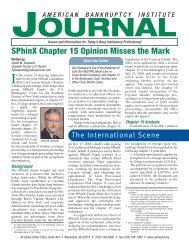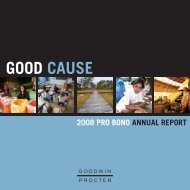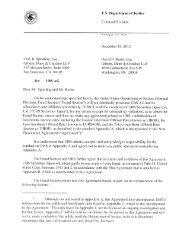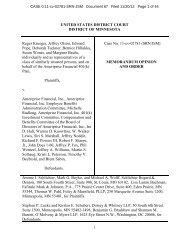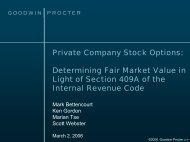FDIC as Receiver for City Bank vs. Conrad D. Hanson and ...
FDIC as Receiver for City Bank vs. Conrad D. Hanson and ...
FDIC as Receiver for City Bank vs. Conrad D. Hanson and ...
You also want an ePaper? Increase the reach of your titles
YUMPU automatically turns print PDFs into web optimized ePapers that Google loves.
C<strong>as</strong>e 2:13-cv-00671 Document 1 Filed 04/15/13 Page 6 of 97<br />
1<br />
2<br />
3<br />
4<br />
5<br />
6<br />
7<br />
8<br />
9<br />
10<br />
11<br />
12<br />
13<br />
14<br />
15<br />
16<br />
17<br />
18<br />
19<br />
20<br />
21<br />
22<br />
23<br />
24<br />
25<br />
26<br />
27<br />
corrected.<br />
21. For example, in 2005, the examiners noted that almost all of <strong>City</strong> <strong>Bank</strong>'s loans <strong>for</strong><br />
the construction of single-family residences ("SFR") had loan-to-value ("LTV") ratios that<br />
exceeded the supervisory LTV limit set <strong>for</strong>th in the Interagency Guidelines <strong>for</strong> Real Estate<br />
Lending, 12 C.F.R. app. A to subpt. A of pt. 365 ("Interagency Guidelines"). Since at le<strong>as</strong>t<br />
1993, the supervisory LTV limits <strong>for</strong> real estate loans under the Interagency Guidelines have not<br />
changed <strong>and</strong> are <strong>as</strong> follows: 65 percent <strong>for</strong> raw l<strong>and</strong>, 75 percent <strong>for</strong> l<strong>and</strong> development, 80 percent<br />
<strong>for</strong> commercial, multifamily, <strong>and</strong> other nonresidential construction, 85 percent <strong>for</strong> one- to fourfamily<br />
residential construction, <strong>and</strong> 85 percent <strong>for</strong> improved property. Loans with LTV ratios in<br />
excess of the supervisory LTV limit must be identified in a bank's records, <strong>and</strong> the aggregate<br />
amount of all loans with LTV ratios above their respective supervisory LTV limits must be<br />
reported at le<strong>as</strong>t quarterly to the bank's board of directors. In addition, the Interagency<br />
Guidelines provide that the aggregate amount of all loans with LTV ratios above their<br />
supervisory LTV limits should not exceed 100 percent of a bank's total capital. In 2005, the<br />
examiners warned the Board <strong>and</strong> senior management that the aggregate amount of <strong>City</strong> <strong>Bank</strong>'s<br />
loans with excessive LTV ratios w<strong>as</strong> 305 percent of total capital. As a result of this high<br />
percentage, the examiners warned <strong>City</strong> <strong>Bank</strong>'s management that they would be subject to<br />
incre<strong>as</strong>ed scrutiny.<br />
22. In addition, the examiners recommended that the <strong>Bank</strong>'s management implement<br />
prompt, comprehensive appraisal reviews to ensure sufficient value in real estate collateral<br />
because the examiners found that the <strong>Bank</strong>'s appraisal review function appeared to be<br />
perfunctory in nature <strong>and</strong> to be per<strong>for</strong>med after loans were committed.<br />
23. In 2005, the examiners also recommended to <strong>City</strong> <strong>Bank</strong>'s Board <strong>and</strong> senior<br />
management that management establish minimum liquidity guidelines <strong>for</strong> construction loan<br />
borrowers. In a memor<strong>and</strong>um to the Board in May 2006, Sheehan dismissed this<br />
recommendation, noting that "putting liquidity constraints on the builders we finance would<br />
subsequently decre<strong>as</strong>e their chances <strong>for</strong> success."<br />
COMPLAINT - Page 6<br />
ATER WYNNE LLP<br />
1652284/1/SKB/105030-0018 601 UNION STREET, SUITE 1501<br />
SEATTLE, WA 98101-3981<br />
(206) 623-4711



